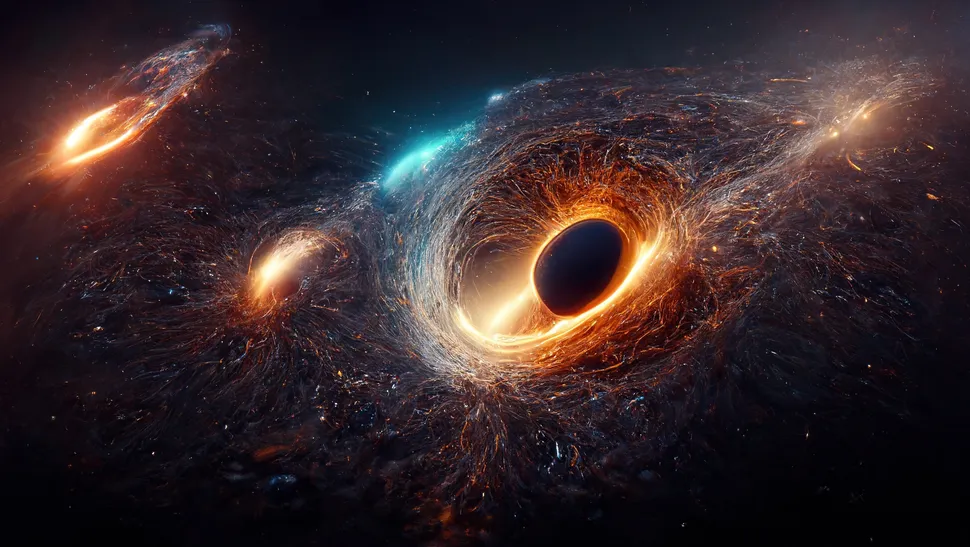Additional dimensions—beyond length, width, height—seem just like the of science fiction. What would additional measurements be like? Is time the fourth measurement? Does string hypothesis require ten or eleven measurements? May profound reality be so unusual? And, anyway, why would we care?
String hypothesis could be a hypothesis of everything that physicists trust will one day clarify … everything.
All the powers, all the particles, all the constants, all the things beneath a single hypothetical roof, where everything that we see is the result of little, vibrating strings. Scholars have been working on the thought since the 1960s, and one of the primary things they realized is that for the hypothesis to work, there got to be more measurements than the four we’re utilized to.
But that thought isn’t as insane because it sounds.
Dimensional disaster
In string hypothesis, small circles of vibrating stringiness (within the hypothesis, they are the basic protest of reality) show as the diverse particles (electrons, quarks, neutrinos, etc.) and as the force-carriers of nature (photons, gluons, gravitons, etc.). The way they do this can be their vibrations. Each string is so little that it shows up to us as nothing more than a point-like molecule, but each string can vibrate with diverse modes, the same way you’ll get distinctive notes out of a guitar string.
Each vibration mode is thought to relate to a diverse kind of molecule. So all the strings vibrating one way see like electrons, all the strings vibrating another way see like photons, and so on. What we see as molecule collisions are, within the string hypothesis see, a bunch of strings consolidating together and part apart.
But for the math to work, there have to be more than four measurements in our universe. Typically since our normal space-time doesn’t deliver the strings enough “room” to vibrate in all the ways they got to in arrange to completely express themselves as all the assortments of particles within the world. They’re fair as well constrained.
In other words, the strings do not fair squirm, they squirm hyperdimensionally.
Current forms of string theory require 10 measurements add up to, whereas an indeed more theoretical über-string theory known as M-theory requires 11. But when we see around the universe, we as it were ever see the regular three spatial measurements also the measurement of time. We’re beautiful beyond any doubt that in case the universe had more than four measurements, we would’ve taken note by now.
How can the string theory’s necessity for additional measurements conceivably be accommodated with our regular encounters within the universe?
Twisted up and compact
Gratefully, string scholars were able to point to a verifiable forerunner for this apparently radical notion.
Back in 1919, in no time after Albert Einstein distributed his theory of common relativity, the mathematician and physicist Theodor Kaluza was playing around with the conditions, fair for fun. And he found something particularly curiously when he included a fifth measurement to the conditions — nothing happened. The conditions of relativity do not truly care approximately the number of measurements; it’s something you’ve got to include in to form the hypothesis pertinent to our universe.
But at that point Kaluza included a uncommon bend to that fifth measurement, making it wrap around itself in what he called the “barrel condition.” This prerequisite made something modern pop out: Kaluza recovered the normal equations of common relativity within the normal four measurements, plus a modern condition that reproduced the expressions of electromagnetism.
It looked like adding dimensions might potentially unify physics.
In hindsight, this was a bit of a ruddy herring.
Still, some of decades later another physicist, Oskar Klein, attempted to allow Kaluza’s thought an translation in terms of quantum mechanics. He found that if this fifth measurement existed and was mindful in some way for electromagnetism, that measurement had to be scrunched down, wrapping back around itself (a bit like Kaluza’s unique thought), but way smaller, down to a uncovered 10^-35 meters.
The numerous manifolds of string theory
If an additional measurement (or measurements) is truly that little, we wouldn’t have taken note by presently. It’s so little that we couldn’t conceivably trust to straightforwardly test it with our high-energy tests. And if those measurements are wrapped up on themselves, at that point each time you move around in four-dimensional space, you’re truly circumnavigating those extra dimensions billions upon billions of times.
And those are the dimensions where the strings of string hypothesis live.
With encourage numerical knowledge, it was found that the additional six spatial measurements required in string hypothesis got to be wrapped up in a specific set of arrangements, known as Calabi-Yao manifolds after two prominent physicists. But there isn’t one unique manifold that’s allowed by sting theory.
There’s around 10^200,000.
It turns out that once you six dimensions to curl up on themselves, and give them almost any possible way to do it, it … adds up.
That’s a lot of different ways to wrap those extra dimensions in on themselves. And each possible configuration will affect the ways the strings inside them vibrate. Since the ways that strings vibrate determine how they behave up here within the world, each choice of manifold leads to a distinct universe with its own set of physics.
So only one manifold can give rise to the world as we experience it. But which one?
Unfortunately, string theory can’t give us an answer, at least not yet. The trouble is that string theory isn’t done — we only have various approximation methods that we hope get close to the real thing, but right now we have no idea how right we are. So we have no mathematical technology for following the chain, from specific manifold to specific string vibration to the physics of the universe.
The response from string theorists is something called the Landscape, a multiverse of all possible universes predicted by the various manifolds, with our universe as just one point among many.

